Investigation of Precise Single-Frequency Time and Frequency Transfer with Galileo E1/E5a/E5b/E5/E6 Observations
Abstract
1. Introduction
2. Materials and Methods
2.1. SF-UC PPP Time and Frequency Transfer Model
2.2. SF-IWC PPP Time and Frequency Transfer Model
2.3. SF-IFH PPP Time and Frequency Transfer Model
2.4. Galileo SF Time and Frequency Transfer Process
3. Results
3.1. Date Selection and Processing Strategies
3.2. Multi-Frequency Observations Quality Analysis
3.3. Time and Frequency Transfer with Different SF PPP Models and Traditional E1 Signal
3.4. SF PPP Time and Frequency Transfer with Multi-Frequency Signals
3.5. SF PPP Time and Frequency Transfer with RTS Products and Multi-Frequency Signals
4. Conclusions
Author Contributions
Funding
Data Availability Statement
Acknowledgments
Conflicts of Interest
References
- Hein, G.W. Status, perspectives and trends of satellite navigation. Satell. Navig. 2020, 1, 22. [Google Scholar] [CrossRef] [PubMed]
- Benedicto, J. Directions 2020: Galileo moves ahead. GPS World 2019, 30, 38–47. [Google Scholar]
- Yang, Y.; Mao, Y.; Sun, B. Basic performance and future developments of BeiDou global navigation satellite system. Satell. Navig. 2020, 1, 1–8. [Google Scholar] [CrossRef]
- Zaminpardaz, S.; Teunissen, P.J.G.; Nadarajah, N. GLONASS CDMA L3 ambiguity resolution and positioning. GPS Solut. 2016, 21, 535–549. [Google Scholar] [CrossRef]
- Montenbruck, O.; Hugentobler, U.; Dach, R.; Steigenberger, P.; Hauschild, A. Apparent clock variations of the Block IIF-1 (SVN62) GPS satellite. GPS Solut. 2012, 16, 303–313. [Google Scholar] [CrossRef]
- Diessongo, T.H.; Schüler, T.; Junker, S. Precise position determination using a Galileo E5 single-frequency receiver. GPS Solut. 2013, 18, 73–83. [Google Scholar] [CrossRef]
- Su, K.; Jin, S.; Jiao, G. Assessment of multi-frequency global navigation satellite system precise point positioning models using GPS, BeiDou, GLONASS, Galileo and QZSS. Meas. Sci. Technol. 2020, 31, 064008. [Google Scholar] [CrossRef]
- Wang, K.; Khodabandeh, A.; Teunissen, P.J.G. Five-frequency Galileo long-baseline ambiguity resolution with multipath mitigation. GPS Solut. 2018, 22, 75. [Google Scholar] [CrossRef]
- Li, X.; Liu, G.; Li, X.; Zhou, F.; Feng, G.; Yuan, Y.; Zhang, K. Galileo PPP rapid ambiguity resolution with five-frequency observations. GPS Solut. 2019, 24, 24. [Google Scholar] [CrossRef]
- Tu, R.; Zhang, P.; Zhang, R.; Liu, J.; Lu, X. Modeling and Assessment of Precise Time Transfer by Using BeiDou Navigation Satellite System Triple-Frequency Signals. Sensors 2018, 18, 1017. [Google Scholar] [CrossRef]
- Su, K.; Jin, S. Triple-frequency carrier phase precise time and frequency transfer models for BDS-3. GPS Solut. 2019, 23, 86. [Google Scholar] [CrossRef]
- Xu, W.; Shen, W.; Cai, C.; Li, L.; Wang, L.; Shen, Z. Modeling and Performance Evaluation of Precise Positioning and Time-Frequency Transfer with Galileo Five-Frequency Observations. Remote Sens. 2021, 13, 2927. [Google Scholar] [CrossRef]
- Zhang, P.; Tu, R.; Gao, Y.; Zhang, R.; Han, J. Performance of Galileo precise time and frequency transfer models using quad-frequency carrier phase observations. GPS Solut. 2020, 24, 40. [Google Scholar] [CrossRef]
- Jin, S.; Su, K. PPP models and performances from single- to quad-frequency BDS observations. Satell. Navig. 2020, 1, 16. [Google Scholar] [CrossRef]
- Ge, Y.; Cao, X.; Shen, F.; Yang, X.; Wang, S. BDS-3/Galileo Time and Frequency Transfer with Quad-Frequency Precise Point Positioning. Remote Sens. 2021, 13, 2704. [Google Scholar] [CrossRef]
- Cai, C.; Gong, Y.; Gao, Y.; Kuang, C. An Approach to Speed up Single-Frequency PPP Convergence with Quad-Constellation GNSS and GIM. Sensors 2017, 17, 1302. [Google Scholar] [CrossRef]
- de Bakker, P.F.; Tiberius, C.C.J.M. Real-time multi-GNSS single-frequency precise point positioning. GPS Solut. 2017, 21, 1791–1803. [Google Scholar] [CrossRef]
- Martínez-Belda, M.C.; Defraigne, P.; Baire, Q.; Aerts, W. Single-frequency time and frequency transfer with Galileo E5. In Proceedings of the 2011 Joint conference of the IEEE international frequency control and the European frequency and time forum (FCS) proceedings, San Francisco, CA, USA, 1–5 May 2011; pp. 1–6. [Google Scholar]
- Hong, J.; Tu, R.; Zhang, R.; Fan, L.; Zhang, P.; Han, J. Contribution analysis of QZSS to single-frequency PPP of GPS/BDS/GLONASS/Galileo. Adv. Space Res. 2020, 65, 1803–1817. [Google Scholar] [CrossRef]
- Hong, J.; Tu, R.; Zhang, R.; Fan, L.; Han, J.; Zhang, P.; Lu, X. Analysis of dual-frequency solution method for single-frequency precise point positioning based on SEID model for GPS and BDS. Measurement 2021, 175, 109102. [Google Scholar] [CrossRef]
- Zhu, S.; Yue, D.; He, L.; Chen, J.; Liu, Z. Comparative analysis of four different single-frequency PPP models on positioning performance and atmosphere delay retrieval. Adv. Space Res. 2021, 67, 3994–4010. [Google Scholar] [CrossRef]
- Shi, C.; Wu, X.; Zheng, F.; Wang, X.; Wang, J. Modeling of BDS-2/BDS-3 single-frequency PPP with B1I and B1C signals and positioning performance analysis. Measurement 2021, 178, 109355. [Google Scholar] [CrossRef]
- Su, K.; Jin, S.; Jiang, J.; Hoque, M.; Yuan, L. Ionospheric VTEC and satellite DCB estimated from single-frequency BDS observations with multi-layer mapping function. GPS Solut. 2021, 25, 68. [Google Scholar] [CrossRef]
- Xiao, X.; Shen, F.; Lu, X.; Shen, P.; Ge, Y. Performance of BDS-2/3, GPS, and Galileo Time Transfer with Real-Time Single-Frequency Precise Point Positioning. Remote Sens. 2021, 13, 4192. [Google Scholar] [CrossRef]
- Zhao, C.; Yuan, Y.; Zhang, B.; Li, M. Ionosphere Sensing with a Low-Cost, Single-Frequency, Multi-GNSS Receiver. IEEE Trans. Geosci. Electron. 2019, 57, 881–892. [Google Scholar] [CrossRef]
- Li, B.; Zang, N.; Ge, H.; Shen, Y. Single-frequency PPP models: Analytical and numerical comparison. J. Geod. 2019, 93, 2499–2514. [Google Scholar] [CrossRef]
- Ge, Y.; Zhou, F.; Dai, P.; Qin, W.; Wang, S.; Yang, X. Precise point positioning time transfer with multi-GNSS single-frequency observations. Measurement 2019, 146, 628–642. [Google Scholar] [CrossRef]
- Zhao, C.; Zhang, B.; Zhang, X. SUPREME: An open-source single-frequency uncombined precise point positioning software. GPS Solut. 2021, 25, 86. [Google Scholar] [CrossRef]
- Wang, S.; Ge, Y.; Meng, X.; Shen, P.; Wang, K.; Ke, F. Modelling and Assessment of Single-Frequency PPP Time Transfer with BDS-3 B1I and B1C Observations. Remote Sens. 2022, 14, 1146. [Google Scholar] [CrossRef]
- Leick, A.; Rapoport, L.; Tatarnikov, D. GPS Satellite Surveying, 4th ed.; John Wiley & Sons: New York, NY, USA, 2015; pp. 1–807. [Google Scholar]
- Bahadur, B.; Nohutcu, M. Comparative analysis of MGEX products for post-processing multi-GNSS PPP. Measurement 2019, 145, 361–369. [Google Scholar] [CrossRef]
- Zhou, F.; Dong, D.; Li, W.; Jiang, X.; Wickert, J.; Schuh, H. GAMP: An open-source software of multi-GNSS precise point positioning using undifferenced and uncombined observations. GPS Solut. 2018, 22, 33. [Google Scholar] [CrossRef]
- Carlin, L.; Hauschild, A.; Montenbruck, O. Precise point positioning with GPS and Galileo broadcast ephemerides. GPS Solut. 2021, 25, 77. [Google Scholar] [CrossRef]
- Zhang, B.; Teunissen, P.J.G.; Yuan, Y.; Zhang, H.; Li, M. Joint estimation of vertical total electron content (VTEC) and satellite differential code biases (SDCBs) using low-cost receivers. J. Geod. 2017, 92, 401–413. [Google Scholar] [CrossRef]
- Ning, Y.; Han, H.; Zhang, L. Single-frequency precise point positioning enhanced with multi-GNSS observations and global ionosphere maps. Meas. Sci. Technol. 2019, 30, 015013. [Google Scholar] [CrossRef]
- Hernández-Pajares, M.; Juan, J.M.; Sanz, J.; Orus, R.; Garcia-Rigo, A.; Feltens, J.; Komjathy, A.; Schaer, S.C.; Krankowski, A. The IGS VTEC maps: A reliable source of ionospheric information since 1998. J. Geod. 2009, 83, 263–275. [Google Scholar] [CrossRef]
- Zhang, L.; Yao, Y.; Peng, W.; Shan, L.; He, Y.; Kong, J. Real-Time Global Ionospheric Map and Its Application in Single-Frequency Positioning. Sensors 2019, 19, 1138. [Google Scholar] [CrossRef]
- Shen, H.; Li, S.; Li, L.; Zhang, W.; Tian, Y.; Hao, W.; Li, R. Evaluation of ionospheric-constrained single-frequency PPP enhanced with an improved stochastic model. Earth Sci. Inform. 2022, 15, 1671–1681. [Google Scholar] [CrossRef]
- Wanninger, L.; Beer, S. BeiDou satellite-induced code pseudorange variations: Diagnosis and therapy. GPS Solut. 2015, 19, 639–648. [Google Scholar] [CrossRef]
- Chen, J.; Yue, D.; Zhu, S.; Chen, H.; Liu, Z.; Zhao, X. Correction model of BDS satellite-induced code bias and its impact on precise point positioning. Adv. Space Res. 2019, 63, 2155–2163. [Google Scholar] [CrossRef]
- Nie, Z.; Yang, H.; Zhou, P.; Gao, Y.; Wang, Z. Quality assessment of CNES real-time ionospheric products. GPS Solut. 2019, 23, 1–15. [Google Scholar] [CrossRef]
- Wang, A.; Chen, J.; Zhang, Y.; Meng, L.; Wang, B.; Wang, J. Evaluating the impact of CNES real-time ionospheric products on multi-GNSS single-frequency positioning using the IGS real-time service. Adv. Space Res. 2020, 66, 2516–2527. [Google Scholar] [CrossRef]
- Liu, Q.; Hernández-Pajares, M.; Yang, H.; Monte-Moreno, E.; Roma-Dollase, D.; García-Rigo, A.; Li, Z.; Wang, N.; Laurichesse, D.; Blot, A.; et al. The cooperative IGS RT-GIMs: A reliable estimation of the global ionospheric electron content distribution in real time. Earth Syst. Sci. Data. 2021, 13, 4567–4582. [Google Scholar] [CrossRef]
- Wang, N.; Yuan, Y.; Li, Z.; Montenbruck, O.; Tan, B. Determination of differential code biases with multi-GNSS observations. J. Geod. 2016, 90, 209–228. [Google Scholar] [CrossRef]
- Petit, G.; Luzum, B. IERS Conventions (2010); Technical Report; Verlag des Bundesamts für Kartographie und Geodäsie: Frankfurtam Main, France, 2010. [Google Scholar]
- Kouba, J. A Guide to Using International GNSS Service (IGS) Products; Jet Propulsion Laboratory: Pasadena, CA, USA, 2009. [Google Scholar]
- Wu, J.-T.; Wu, S.C.; Hajj, G.A.; Bertiger, W.I.; Lichten, S.M. Effects of antenna orientation on GPS carrier phase. In Proceedings of the Astrodynamics 1991, San Diego, CA, USA, 19–22 August 1991; pp. 1647–1660. [Google Scholar]
- Yuan, Y.; Huo, X.; Ou, J.; Zhang, K.; Chai, Y.; Wen, D.; Grenfell, R. Refining the Klobuchar ionospheric coefficients based on GPS observations. IEEE Trans. Mil. Electron. 2008, 44, 1498–1510. [Google Scholar] [CrossRef]
- Böhm, J.; Niell, A.; Tregoning, P.; Schuh, H. Global Mapping Function (GMF): A new empirical mapping function based on numerical weather model data. Geophys. Res. Lett. 2006, 33, 3–6. [Google Scholar] [CrossRef]
- Petit, G. The TAIPPP pilot experiment. In Proceedings of the 2009 IEEE International Frequency Control Symposium Joint with the 22nd European Frequency and Time forum, Besançon, France, 20–24 April 2009; pp. 116–119. [Google Scholar]
- Lv, D.; Zeng, F.; Han, Y.; Ouyang, X. BDS PPP ambiguity resolution and its application on time and frequency transfer. In China Satellite Navigation Conference; Springer: Singapore, 2020; pp. 573–585. [Google Scholar]
- Allan, D.W.; Weiss, M.A. Accurate time and frequency transfer during common-view of a GPS satellite. In Proceedings of the 1980 IEEE Frequency Control Symp, Philadelphia, PA, USA, 28–30 May 1980; pp. 334–346. [Google Scholar]
- Weinbach, U.; Schön, S. GNSS receiver clock modeling when using high-precision oscillators and its impact on PPP. Adv. Space Res. 2011, 47, 229–238. [Google Scholar] [CrossRef]
- Bartoccini, U.; Barchi, G.; Nunzi, E. Methods and tools for frequency jump detection. In Proceedings of the 2009 IEEE International Workshop on Advanced Methods for Uncertainty Estimation in Measurement, Bucharest, Romania, 6–7 July 2009; pp. 109–112. [Google Scholar]

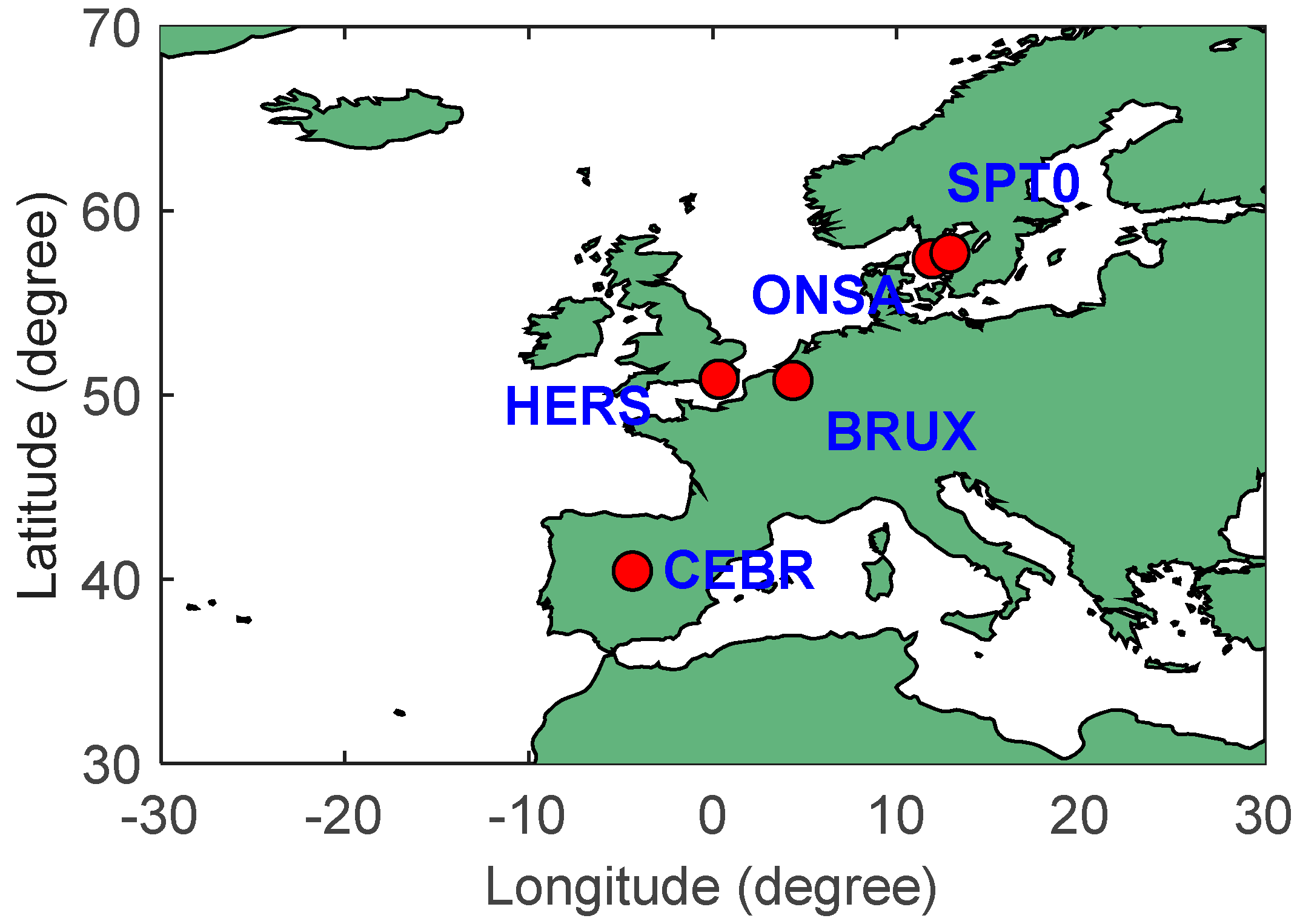
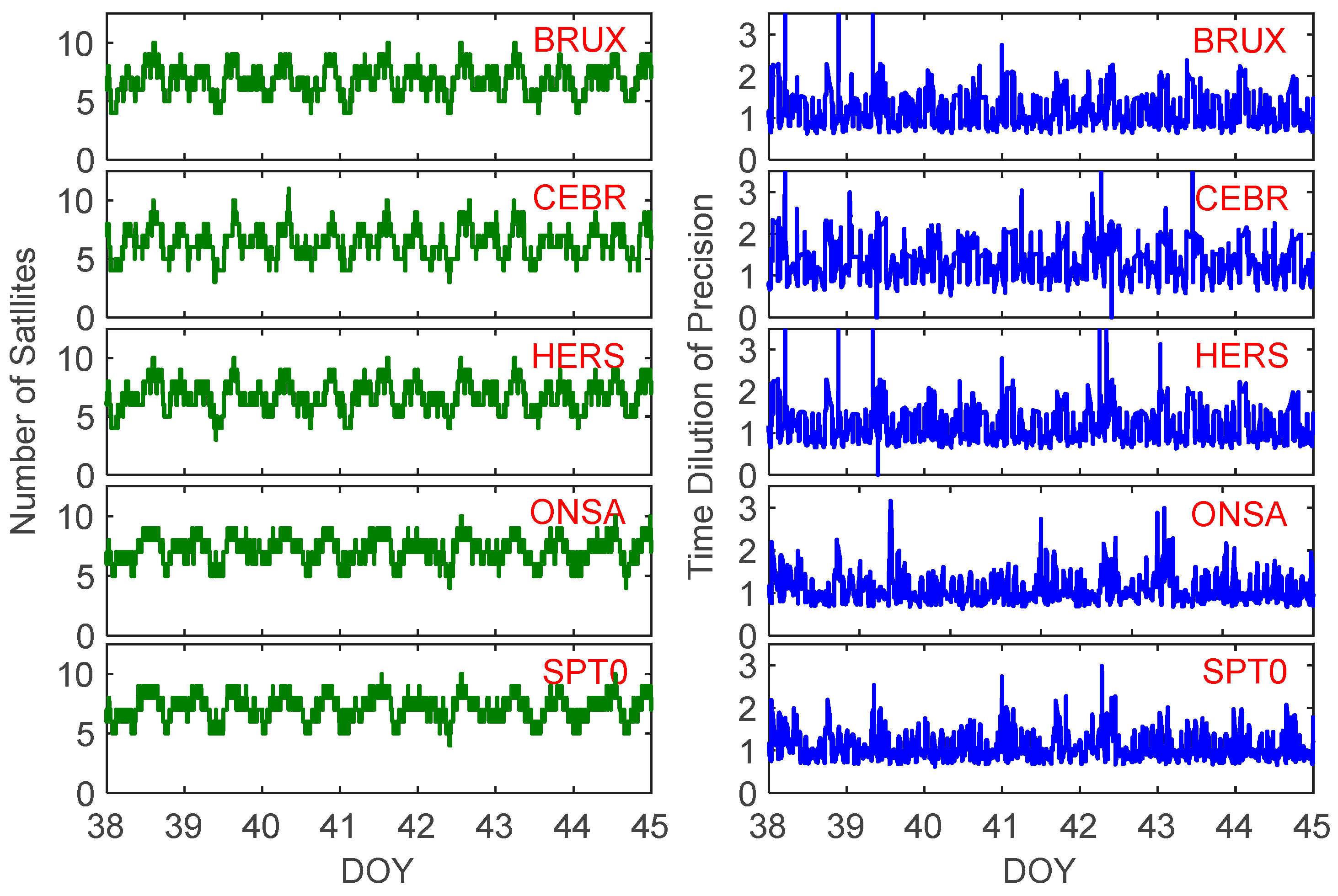

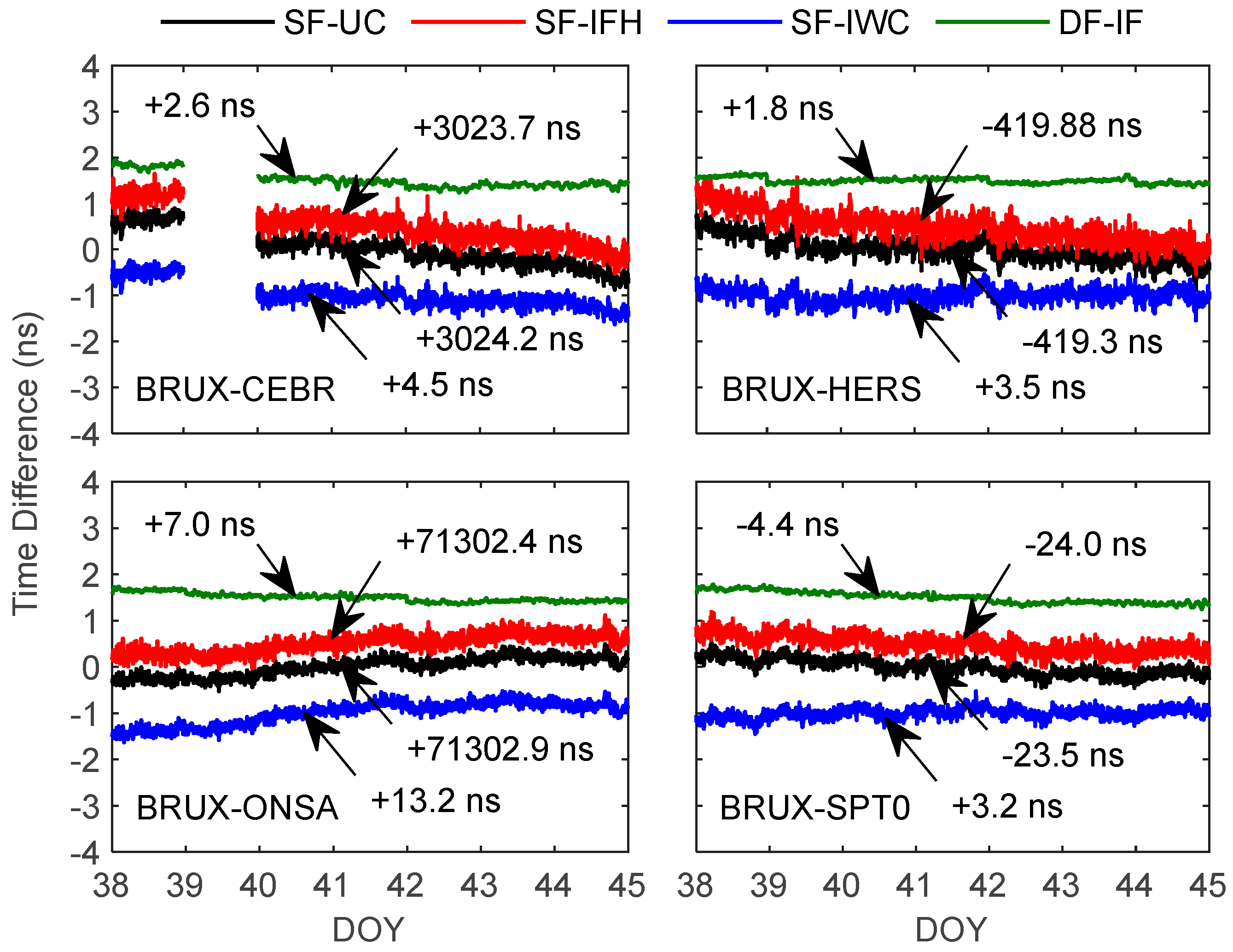

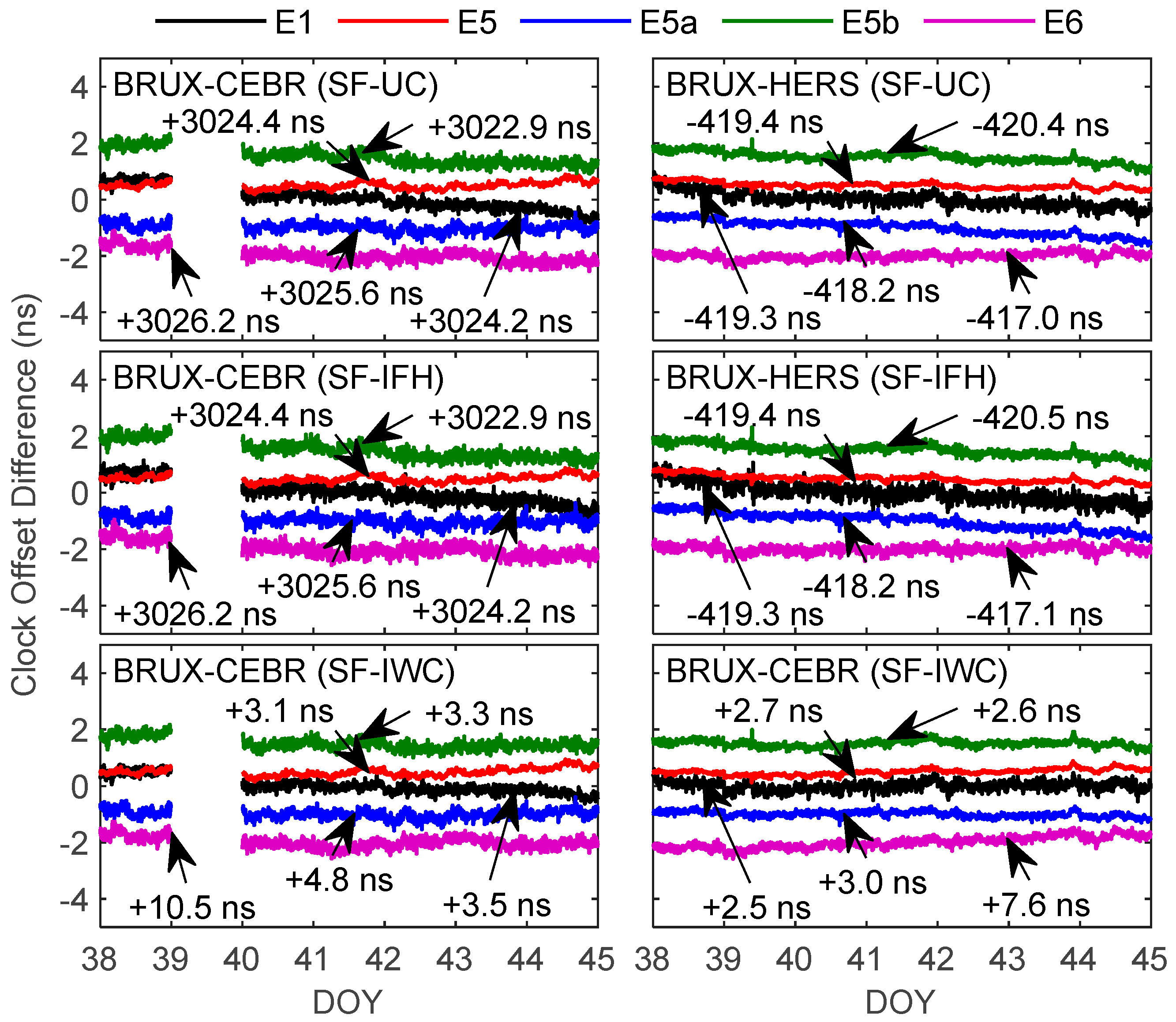
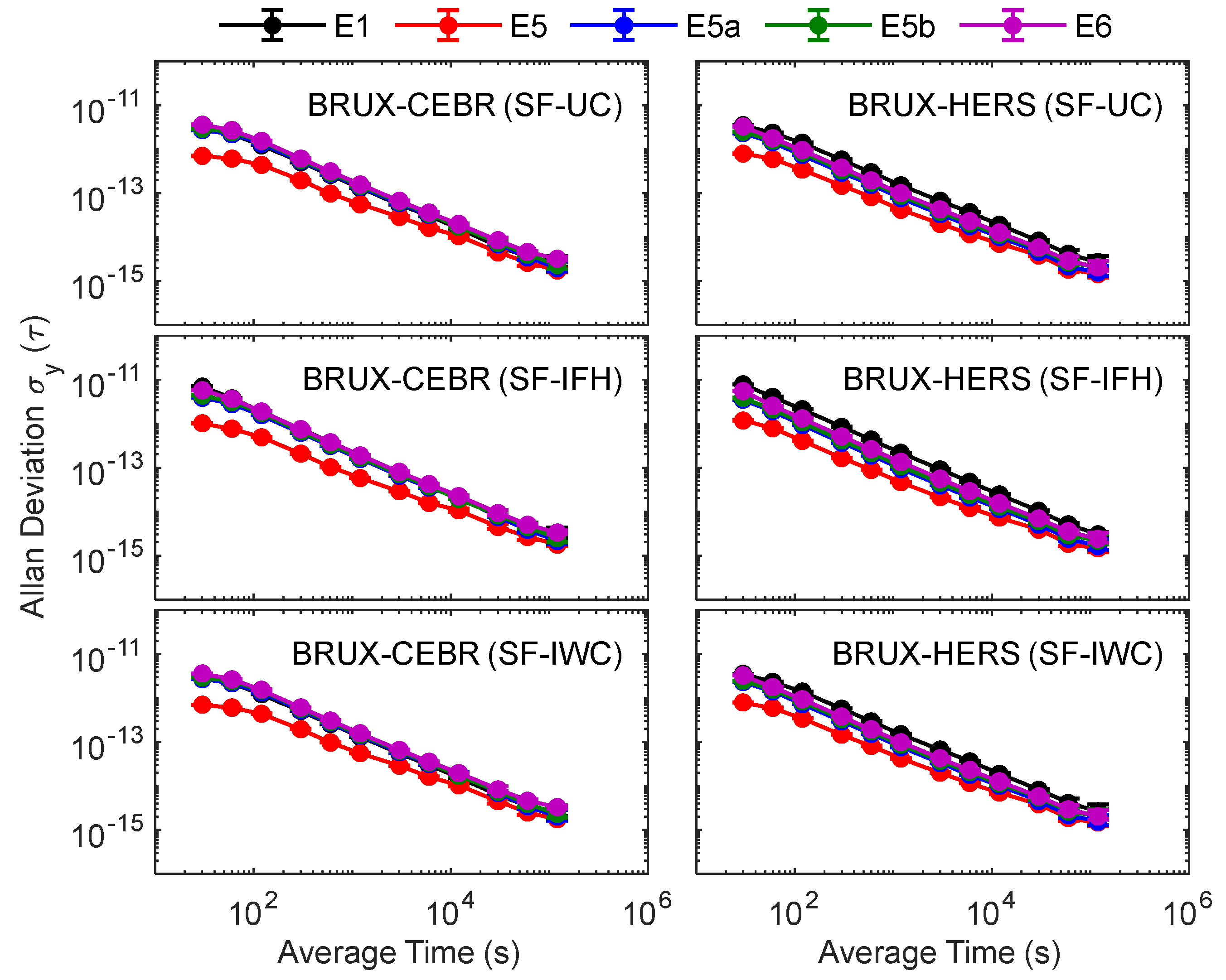
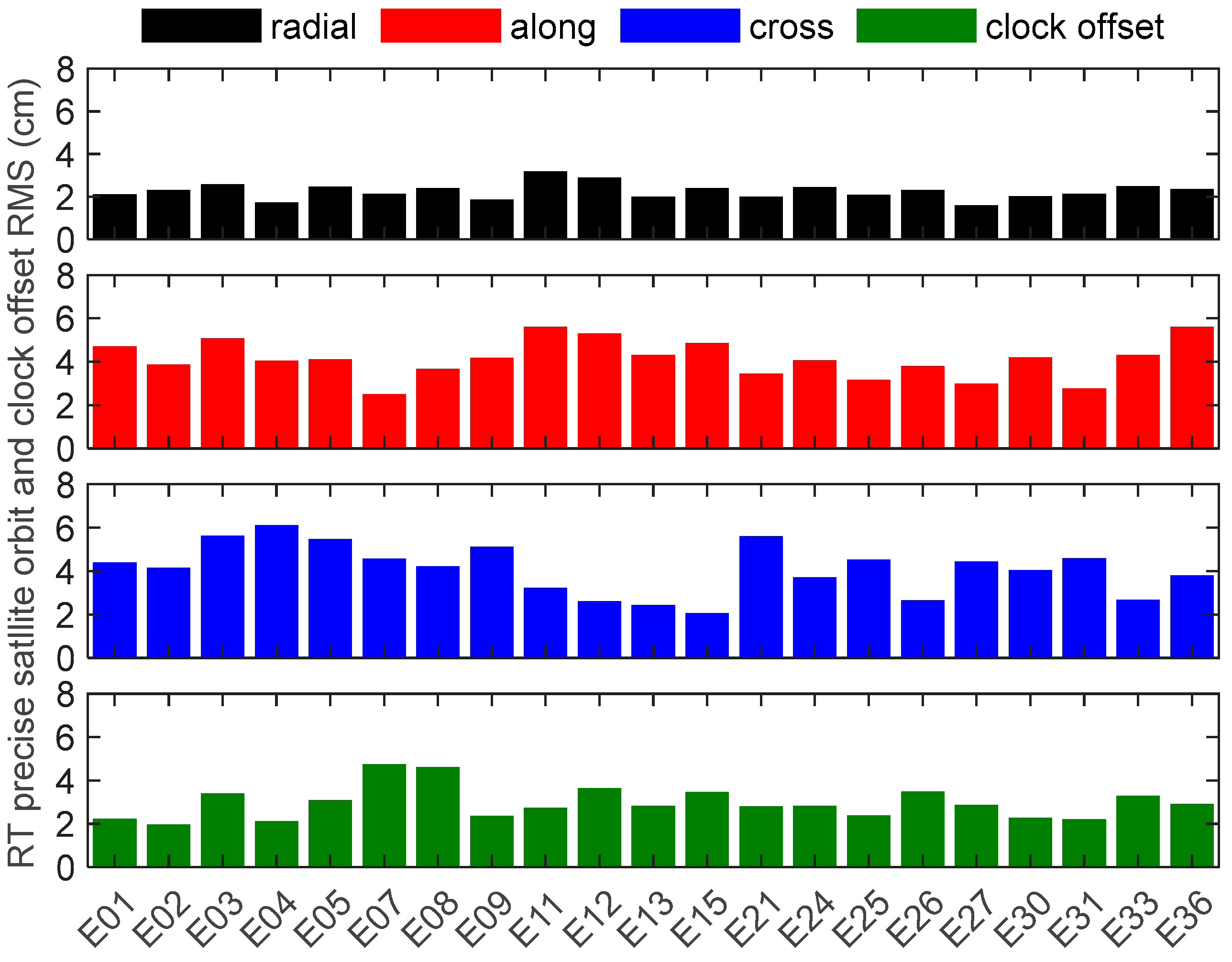

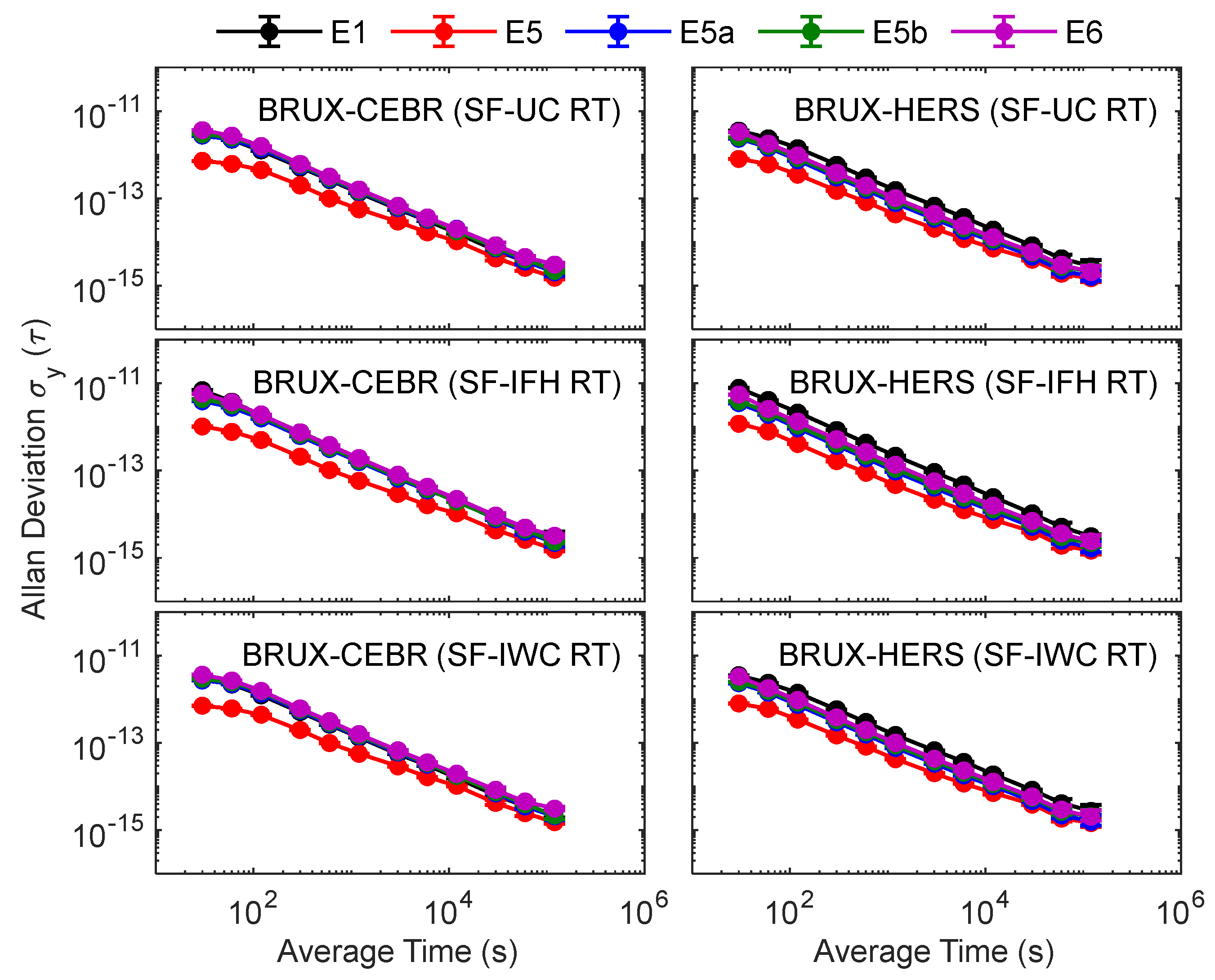
| Station | Receiver | Antenna | Location |
|---|---|---|---|
| BRUX | SEPT POLARX5TR | JAVRINGANT_DM | Brussels, Belgium |
| CEBR | SEPT POLARX5TR | SEPCHOKE_B3E6 | Cebreros, Spain |
| HERS | SEPT POLARX5TR | LEIAR25.R3 | Hailsham, UK |
| ONSA | SEPT POLARX5TR | AOAD/M_B | Onsala, Sweden |
| SPT0 | SEPT POLARX5TR | TRM59800.00 | Boras, Sweden |
| Item | Strategy |
|---|---|
| Observation | E1, E5, E5a, E5b, and E6 |
| Elevation cut-off | 7° |
| Orbit and clock | CNES GRG final and SSRC00CNE0 RTS products |
| Satellite DCB | CAS products [44] |
| Earth rotation | Corrected [45] |
| Relativistic effect | Corrected [46] |
| Phase windup | Corrected [47] |
| Tide effect | Solid Earth, pole, and ocean tide [45] |
| PCO/PCV | Corrected, using IGS14.atx file |
| Coordinate | Fixed by IGS SNX weekly solution file |
| Receiver clock | Estimated as white noises (104 m2) |
| Ionospheric | SF-UC/SF-IWC: estimated as white noise (104 m2) [48]; SF-IFH: eliminated by IFH combination |
| Tropospheric dry delay | Saastamoinen model corrected |
| Tropospheric wet delay | Estimated as a random walk (10−8 m2/s) withglobal mapping function (GMF) [49] |
| Ambiguities | Estimated as constants, float solution |
| Item | Link | SF-UC | SF-IFH | SF-IWC | DF-IF |
|---|---|---|---|---|---|
| STD (ps) | BRUX-CEBR | 120.88 | 153.54 | 115.63 | 41.37 |
| BRUX-HERS | 139.23 | 176.51 | 139.51 | 24.78 | |
| BRUX-ONSA | 85.53 | 113.92 | 90.47 | 26.70 | |
| BRUX-SPT0 | 101.84 | 126.55 | 96.15 | 31.03 | |
| Reduced (%) | BRUX-CEBR | 65.8 | 57.2 | 50.6 | / |
| BRUX-HERS | 82.2 | 53.4 | 61.7 | / | |
| BRUX-ONSA | 68.8 | 39.6 | 56.2 | / | |
| BRUX-SPT0 | 69.5 | 45.1 | 53.1 | / |
| Average Time/s | SF-UC | SF-IFH | SF-IWC | DF-IF |
|---|---|---|---|---|
| 30 | 294.60 | 652.30 | 294.60 | 21.75 |
| 60 | 193.10 | 340.70 | 193.10 | 11.97 |
| 120 | 111.30 | 172.90 | 111.30 | 7.14 |
| 300 | 46.63 | 69.38 | 46.62 | 4.16 |
| 600 | 24.09 | 35.34 | 24.09 | 3.13 |
| 1200 | 12.20 | 17.69 | 12.20 | 2.44 |
| 3000 | 5.22 | 7.32 | 5.23 | 1.50 |
| 6000 | 2.85 | 3.83 | 2.85 | 0.89 |
| 12,000 | 1.50 | 1.98 | 1.50 | 0.47 |
| 30,000 | 0.66 | 0.83 | 0.66 | 0.22 |
| 60,000 | 0.35 | 0.43 | 0.35 | 0.13 |
| 120,000 | 0.24 | 0.28 | 0.24 | 0.12 |
| Model | Signal | BRUX-CEBR | BRUX-HERS | BRUX-ONSA | BRUX-SPT0 |
|---|---|---|---|---|---|
| SF-UC | E1 | 120.88 | 139.23 | 85.53 | 101.84 |
| E5 | 88.96 | 58.17 | 64.71 | 60.95 | |
| E5a | 128.67 | 77.90 | 66.07 | 95.43 | |
| E5b | 126.63 | 90.30 | 114.60 | 112.06 | |
| E6 | 137.57 | 100.19 | 75.41 | 94.05 | |
| SF-IFH | E1 | 153.54 | 176.51 | 113.92 | 126.45 |
| E5 | 88.26 | 59.33 | 66.03 | 63.07 | |
| E5a | 136.96 | 88.44 | 73.62 | 103.70 | |
| E5b | 139.32 | 101.20 | 119.81 | 117.75 | |
| E6 | 156.23 | 115.48 | 85.70 | 106.52 | |
| SF-IWC | E1 | 115.63 | 139.51 | 90.65 | 96.15 |
| E5 | 90.02 | 62.85 | 54.70 | 64.34 | |
| E5a | 128.38 | 74.07 | 68.42 | 97.65 | |
| E5b | 126.10 | 90.13 | 92.78 | 102.32 | |
| E6 | 140.33 | 108.88 | 84.34 | 101.15 |
| Average Time/s | E1 | E5 | E5a | E5b | E6 |
|---|---|---|---|---|---|
| 30 | 413.83 | 87.63 | 254.70 | 283.33 | 351.20 |
| 60 | 242.30 | 65.75 | 167.23 | 187.70 | 207.27 |
| 120 | 131.83 | 40.23 | 91.57 | 105.50 | 112.33 |
| 300 | 54.21 | 17.68 | 37.18 | 41.87 | 44.87 |
| 600 | 27.84 | 9.32 | 19.03 | 21.32 | 22.83 |
| 1200 | 14.03 | 5.04 | 9.67 | 10.87 | 11.66 |
| 3000 | 5.92 | 2.41 | 4.17 | 4.66 | 4.99 |
| 6000 | 3.18 | 1.41 | 2.28 | 2.52 | 2.68 |
| 12,000 | 1.66 | 0.89 | 1.35 | 1.36 | 1.47 |
| 30,000 | 0.72 | 0.43 | 0.58 | 0.63 | 0.64 |
| 60,000 | 0.38 | 0.22 | 0.30 | 0.34 | 0.34 |
| 120,000 | 0.26 | 0.18 | 0.20 | 0.22 | 0.23 |
| Model | Signal | BRUX-CEBR | BRUX-HERS | BRUX-ONSA | BRUX-SPT0 |
|---|---|---|---|---|---|
| SF-UC | E1 | 128.21 | 138.55 | 92.22 | 99.20 |
| E5 | 79.24 | 59.92 | 59.90 | 65.91 | |
| E5a | 128.63 | 75.48 | 66.65 | 98.98 | |
| E5b | 128.94 | 89.27 | 107.12 | 105.96 | |
| E6 | 137.15 | 104.31 | 83.03 | 100.74 | |
| SF-IFH | E1 | 160.28 | 174.92 | 118.86 | 124.94 |
| E5 | 79.21 | 60.61 | 60.82 | 68.49 | |
| E5a | 136.94 | 85.32 | 74.21 | 107.47 | |
| E5b | 141.68 | 99.62 | 111.94 | 111.67 | |
| E6 | 156.66 | 119.45 | 92.91 | 112.92 | |
| SF-IWC | E1 | 118.00 | 139.50 | 94.77 | 96.64 |
| E5 | 81.10 | 63.57 | 56.50 | 68.90 | |
| E5a | 126.98 | 74.24 | 71.66 | 100.40 | |
| E5b | 124.26 | 89.84 | 91.37 | 100.27 | |
| E6 | 137.67 | 109.51 | 90.18 | 106.02 | |
| DF-IF | E1/E5a | 57.00 | 25.93 | 31.87 | 34.37 |
| Average Time/s | E1 | E5 | E5a | E5b | E6 | E1/E5a |
|---|---|---|---|---|---|---|
| 30 | 413.83 | 87.65 | 264.90 | 281.07 | 351.17 | 21.93 |
| 60 | 242.30 | 65.78 | 172.53 | 184.70 | 207.23 | 12.07 |
| 120 | 131.83 | 40.24 | 94.21 | 103.67 | 112.33 | 7.23 |
| 300 | 54.21 | 17.67 | 38.21 | 41.50 | 44.87 | 4.26 |
| 600 | 27.84 | 9.32 | 19.51 | 21.12 | 22.82 | 3.30 |
| 1200 | 14.04 | 5.04 | 9.90 | 10.80 | 11.66 | 2.69 |
| 3000 | 5.93 | 2.40 | 4.26 | 4.63 | 4.99 | 1.79 |
| 6000 | 3.18 | 1.42 | 2.32 | 2.50 | 2.68 | 1.05 |
| 12,000 | 1.66 | 0.89 | 1.37 | 1.36 | 1.47 | 0.56 |
| 30,000 | 0.71 | 0.43 | 0.58 | 0.64 | 0.64 | 0.24 |
| 60,000 | 0.37 | 0.22 | 0.30 | 0.34 | 0.34 | 0.15 |
| 120,000 | 0.26 | 0.18 | 0.21 | 0.22 | 0.23 | 0.13 |
Publisher’s Note: MDPI stays neutral with regard to jurisdictional claims in published maps and institutional affiliations. |
© 2022 by the authors. Licensee MDPI, Basel, Switzerland. This article is an open access article distributed under the terms and conditions of the Creative Commons Attribution (CC BY) license (https://creativecommons.org/licenses/by/4.0/).
Share and Cite
Xu, W.; Yan, C.; Chen, J. Investigation of Precise Single-Frequency Time and Frequency Transfer with Galileo E1/E5a/E5b/E5/E6 Observations. Remote Sens. 2022, 14, 5371. https://doi.org/10.3390/rs14215371
Xu W, Yan C, Chen J. Investigation of Precise Single-Frequency Time and Frequency Transfer with Galileo E1/E5a/E5b/E5/E6 Observations. Remote Sensing. 2022; 14(21):5371. https://doi.org/10.3390/rs14215371
Chicago/Turabian StyleXu, Wei, Chao Yan, and Jian Chen. 2022. "Investigation of Precise Single-Frequency Time and Frequency Transfer with Galileo E1/E5a/E5b/E5/E6 Observations" Remote Sensing 14, no. 21: 5371. https://doi.org/10.3390/rs14215371
APA StyleXu, W., Yan, C., & Chen, J. (2022). Investigation of Precise Single-Frequency Time and Frequency Transfer with Galileo E1/E5a/E5b/E5/E6 Observations. Remote Sensing, 14(21), 5371. https://doi.org/10.3390/rs14215371







